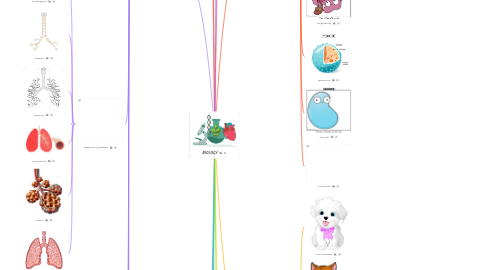
1. Cell Division
1.1. Cancer
1.1.1. Tumours
1.1.1.1. Malignant
1.1.1.2. Benign
1.1.1.3. Mestasis
1.1.2. Testing and Treatment
1.1.2.1. Imaging Technology
1.1.2.2. Examaining Cells
1.1.2.3. Radiology
1.1.2.4. Chemotherapy
1.1.2.5. Surgery
2. Specialized Cells
2.1. Compartmentalization
2.2. Cellular differentiation
2.3. Stem Cells
2.3.1. Embryonic Stem Cells
2.3.2. Tissue Stem Cells
2.4. Specialized Animal Cell examples
2.4.1. Muscle Cells
2.4.2. Skin Cells
2.4.3. Red Blood Cells
2.5. Specialized Plant Cell examples
2.5.1. Guard Cells
2.5.2. Xylem and Pholem
2.5.3. Epidermal Cells
3. Animal Systems Continued
3.1. Hierarchy of Structure
3.2. Tissue regeneration
4. Organ systems
4.1. Digestive System
4.1.1. Esophagus
4.1.2. Stomach
4.1.3. Small Intestine
4.1.4. Large Intestine
4.1.5. Liver
4.1.6. Gall Bladder
4.1.7. Mouth
4.1.8. Pancreas
4.1.9. Rectum
4.2. Circulatory System
4.2.1. Blood vessels
4.2.1.1. Capillaries
4.2.1.2. Veins
4.2.1.3. Arteries
4.2.2. Heart
4.3. Respiratory System
4.3.1. Diaphgram
4.3.2. Trachea
4.3.3. Bronchi
4.3.4. Bronchiole
4.3.5. Alveoli
4.3.6. Lungs
4.4. Muskoskeletal System
4.4.1. Muscles
4.4.2. Tendons
4.5. Nervous System
4.5.1. Central Nervous System
4.5.1.1. Brain
4.5.1.2. Spinal Cord
4.5.2. Peripheral Nervous System
4.5.2.1. Nerves
4.6. Endocrine System
4.6.1. Thyroid
4.6.2. Pancreas
4.7. Skeletal System
4.7.1. Bones
4.7.2. Ligaments
5. Organ transplantation
5.1. Xenotransplantation
5.2. Dangers
5.3. Benefits
5.4. Deceased Organ Donors
5.5. Ethics and Morality
5.6. Living Organ Donors
6. Systems Interacting
6.1. Digestive and Circulatory
6.2. Digestive and Respiratory
6.3. Circulatory and Respiratory
6.4. Muskoskeletal and Circulatory System
6.5. Muskoskeletal System and Integumentary System (Birds)
7. Diffusion and Osmosis
7.1. Diffusion
7.2. Osmosis
8. Tissues
8.1. Connective
8.1.1. Bone
8.1.2. Tendons
8.1.3. Blood
8.1.3.1. Plasma
8.1.3.2. White Blood Cells
8.1.3.3. Red Blood Cells
8.1.3.4. Platelets
8.1.4. Fat (Apidose)
8.2. Epithelial
8.2.1. Squamous
8.2.2. Columnar
8.3. Nervous
8.3.1. Brain
8.3.2. Nerves
8.4. Muscle
8.4.1. Cardiac
8.4.2. Skeletal
8.4.3. Smooth
9. Cells of Organisms
9.1. Plant Cells
9.2. Animal Cells
9.3. Prokaryotes
9.4. Eukrayotes
9.5. Microscope
9.5.1. Microscope Diagrams
10. Cell Theory
10.1. Modern Cell theory
11. Cell Cycle
11.1. Interphase
11.1.1. G1 phase
11.1.2. S phase
11.1.3. G2 phase
11.2. Mitosis
11.2.1. Prophase
11.2.2. Metaphase
11.2.3. Anaphase
11.2.4. Telophase
11.2.5. Daughter Cells
11.2.6. Chromosome
11.2.7. Chromatid
11.2.8. Centromere
11.2.9. Spindle Fibers
11.3. Cytokinesis
11.3.1. Cleavage Furrow
11.3.2. Cell plate
12. Organelles
12.1. Mitochondria
12.1.1. Cellular Respiration
12.2. Endoplasmic Reticulum
12.2.1. Smooth Endoplasmic Reticulum
12.2.2. Rough Endoplasmic Reticulum
12.3. Nucleus
12.4. Cytoplasm
12.5. Chloroplast
12.6. Golgi Body
12.7. Lysosome
12.8. Vacuole
12.9. Centrioles
13. 7 Characteristics of Life
13.1. Homeostasis
13.2. Acquire Energy
13.3. Responsiveness
13.4. Reproduction
13.5. Adaptation
13.6. Order and Organization
13.7. Growth and Development
14. Plant Systems
14.1. Plant tissues
14.1.1. Plant tissues interacting
14.1.1.1. Absorbing Light
14.1.1.1.1. Chlorophyll
14.1.1.1.2. Palisade Layer
14.1.1.1.3. Spongy Mesophyll
14.1.1.2. Obtaining CO2
14.1.1.2.1. Cuticle
14.1.1.2.2. Stomate
14.1.1.2.3. Guard Cells
14.1.1.3. Obtaining Water
14.1.2. Meristematic Cells
14.1.3. Dermal Tissue
14.1.4. Vascular Tissue
14.1.4.1. Xylem
14.1.4.2. Phloem
14.2. Shoot System
14.2.1. Photosynthesis
14.2.2. Leaf
14.2.3. Flower
14.2.3.1. Female Parts
14.2.3.2. Male parts
14.2.4. Stem
14.3. Root System and types
14.3.1. Taproots
14.3.2. Fibrous
14.3.3. Adventitous
